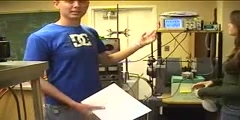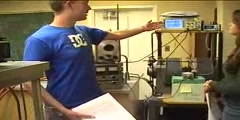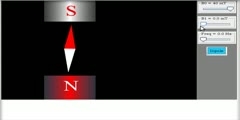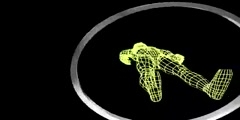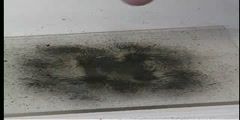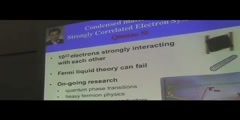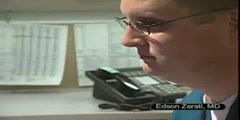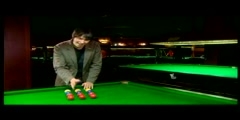Lec 29 - Physics 111: Nuclear Magnetic Resonance (NMR) Part-1 Continuous Wave
Physics 111: Nuclear Magnetic Resonance (NMR) Part-1 Continuous Wave Physics 111 Advanced Laboratory. Professor Sumner Davis This video part 1 accompanies the Nuclear Magnetic Resonance Experiment, providing students with an introduction to the theory, apparatus, and procedures. In the NMR experiment, nuclear dipoles (the samples) are subjected to a static magnetic field of about 4000 gauss as well as a time-varying radio-frequency magnetic field perpendicular to the static field. The static field causes Zeeman-effect splitting between sub-states, and the radio frequency field is tuned to the Larmor frequency so that it induces transitions between the sub-states. The resonance condition is observed using the Bloch two-coil induction technique. You will observe proton and fluorine nuclei. You will learn techniques of lock-in detection and signal averaging. http://advancedlab.org
Video is embedded from external source so embedding is not available.
Video is embedded from external source so download is not available.
Channels: Physics (General)
Tags: Physics 111: Nuclear Magnetic Resonance (NMR) Part-1 Continuous Wave
Uploaded by: berkeleyphy111 ( Send Message ) on 19-09-2012.
Duration: 18m 22s
Here is the next lecture for this course
Lec 30 - Physics 111: Nuclear Magnetic Re ...
21:38 | 4345 viewsNuclear Magnetic Resonance
04:15 | 5127 viewsNuclear Magnetic Resonance NMR
08:43 | 9298 viewsNuclear Magnetic Resonance Video
04:15 | 5035 viewsMagnetic resonance as used in NMR and MRI
05:09 | 5159 viewsLec 2 - Physics 111: Atomic Physics (ATM) ...
32:01 | 5106 viewsLec 24 - Physics 111: Non-Linear Spectros ...
01:01:25 | 4159 viewsLec 25 - Physics 111: Non-Linear Spectros ...
34:46 | 3645 viewsNuclear magnetic resonance NMR in Spanish
00:35 | 4302 viewsPhysics Lab Demo 6: Magnetic Field
02:26 | 14382 viewsRice U Physics and Astronomy: Condensed M ...
07:21 | 6114 viewsMagnetic Resonance Imaging
06:41 | 5905 viewsLec 1 - Physics 111: Atomic Physics (ATM) ...
20:54 | 4499 viewsLec 18 - Physics 111: Energy Levels Lectu ...
35:01 | 3574 viewsThe Standard Model of Particle Physics (P ...
03:07 | 11540 viewsNo content is added to this lecture.
This video is a part of a lecture series from of berkeley
Lecture list for this course
Lec 1 - Physics 111: Atomic Physics (ATM) Part 1. Balmer Series
Lec 2 - Physics 111: Atomic Physics (ATM) Part 2. Zeeman Effect
Lec 3 - Physics 111: Beta Ray Spectroscopy (BRA)
Lec 4 - Physics 111: Brownian Motion in Cells (BMC)
Lec 5 - Physics 111: Instrumentation Section Lab Equipment (BSC)
Lec 6 - Physics 111: Bubble Chamber (BBC)
Lec 7 - Physics 111: Carbon Dioxide Laser (CO2)
Lec 8 - Physics 111: Compton Scattering (COM)
Lec 9 - Physics 111: Gamma Ray Spectroscopy (GMA)
Lec 10 - Physics 111: Hall Effect In A Plasma (HAL)
Lec 11 - Physics 111: Holography (HOL)
Lec 12 - Physics 111: Introduction to Error Analysis
Lec 13 - Physics 111: Josephson Junction Effect (JOS)
Lec 14 - Physics 111: Radiation and Laboratory Safety
Lec 15 - Physics 111: Laser Safety
Lec 16 - Physics 111: Atomic Physics (ATM) Theory Lecture ONLY
Lec 17 - Physics 111: Energy Levels Lecture Part 1
Lec 18 - Physics 111: Energy Levels Lecture Part 2
Lec 19 - Physics 111 Light Sources and Detectors Lecture
Lec 20 - Physics 111: Optical Instruments Lecture
Lec 21 - Physics 111: Energy Transitions Lecture Series
Lec 22 - Physics 111: Laser Induced Fluorescence and Raman Scattering (LIF)
Lec 23 - Physics 111: Low Light Signal Measurements (LLS)
Lec 24 - Physics 111: Non-Linear Spectroscopy and Magneto-Optics Part 1 (MNO)
Lec 25 - Physics 111: Non-Linear Spectroscopy and Magneto-Optics Part 2 (MNO)
Lec 26 - Physics 111: Atom Trapping (MOT)
Lec 27 - Physics 111: Muon Lifetime (MUO)
Lec 28 - Physics 111: Non-Linear Dynamics and Chaos (NLD)
Lec 30 - Physics 111: Nuclear Magnetic Resonance Part-2 Pulsed NMR
Lec 31 - Physics 111: Optical Pumping (OPT)
Lec 32 - Physics 111: How to do an Oral Report
Lec 33 - Physics 111: Optical Trapping (OTZ)
Lec 34 - Physics 111: Rutherford Scattering (RUT)
Lec 35 - Physics 111: Hall Effect In A Semiconductor

